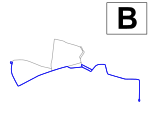Trolleybuses in Słupsk
| Trolleybuses in Słupsk | |||
|---|---|---|---|
 Jelcz PR110E trolleybus, 1999 | |||
| Overview | |||
| Locale | |||
| Transit type | trolleybus | ||
| Number of lines | 3 | ||
| Line number | A-C | ||
| Website | http://www.mzk.slupsk.pl | ||
| Operation | |||
| Began operation | 21 July 1985[1] | ||
| Ended operation | 18 October 1999 | ||
| Operator(s) | MZK Słupsk | ||
| Number of vehicles | 5 | ||
| Technical | |||
| System length | 12 mi (19 km) | ||
| |||
| |||||||||||||||||||||||||||||||||||||||||||||||||||||||||||||||||||||||||||||||||||||||||||||||||||||||||||||||||||||||||||||||||||||||||||||||||||||||||||||||||
The Słupsk trolleybus system was a trolleybus network operated by MPK Słupsk in Słupsk, Poland, from 1985 to 1999.[2][3] The system measured at the most 19.1 km on three lines.
History
[edit]The first trolleybus projects in Słupsk date back to the 1930s, when one trolleybus line was planned. It was to connect Kobylnica with Brusków Wielki. This plan was not implemented.[4]
At the end of the 1970s, the voivodeship transport company WPKM Słupsk developed a project of Słupsk trolleybus system.[4] The plan assumed the construction of five trolleybus lines, including one to Ustka, 18 km away from Słupsk. First construction works began in April 1985.[5]
The opening of the first line, marked with A, took place on 21 July 1985.[1] The line was served by ten ZiU-9 trolleybuses purchased from the USSR.[6] The next two lines were launched on 11 November 1986 (B) and 27 June 1987 (C).[7] Bad economic situation does not allowed the opening of lines D and E.[8]
In the early 1990s, eleven functional trolleybuses were scrapped. This caused rolling stock problems and forced trolleybuses to be supported by buses. However, three buses were converted into trolleybuses.[4]
In July 1997, MZK Słupsk exchanged seven operational trolleybuses for seven buses from Tychy.[6] The remaining vehicles were not enough to fully serve the system. The network's profitability has dropped dramatically. Until 1999, only seven trolleybuses were able to operate.[4] It started first voice opinions about the network closure. Pro-decommission arguments were as follows:[4]
- maintaining infrastructure for five vehicles is not cost-effective[4]
- cables supplying the rectifier station should be replaced
- trolleybuses slow down the traffic[6]
- the network is old and exploited
- rectifier stations produce too much electric energy
In May 1999 began dismantling of the overhead lines at Hubalczyków street, meaning the end of lines B and C. On 18 October 1999, the last A-line trolleybuses went into the streets.[8]
Lines
[edit]Lines as of 1987:[4]
References
[edit]Notes
[edit]- ^ a b Murray, Alan (2000). World Trolleybus Encyclopaedia. Yateley, Hampshire, UK: Trolleybooks. p. 71. ISBN 0-904235-18-1.
- ^ "Dziesięć lat temu zlikwidowano słupskie trolejbusy". Głos Pomorza (in Polish). 29 March 2009. Retrieved 2020-06-12.
- ^ "HISTORIA". www.mzk.slupsk.pl. Retrieved 2020-06-12.
- ^ a b c d e f g Połom, Marcin (2013). "Trolejbusy w obsłudze komunikacyjnej Słupska w latach 1985–1999" (PDF). Autobusy: technika, eksploatacja, systemy transportowe. 14: 36–42.
- ^ "Słupsk: Dziesięć lat temu zlikwidowano słupskie trolejbusy". infobus.pl (in Polish). Retrieved 2020-06-13.
- ^ a b c "20 lat temu ulicami Słupska przejechał ostatni trolejbus. Pozostały tylko częściowo zdemontowane słupy trakcyjne". radiogdansk.pl (in Polish). Retrieved 2020-06-13.
- ^ "Historia trolejbusów w Słupsku, cz. I | artykuły – Pomorskie Stowarzyszenie Sympatyków Transportu Miejskiego" (in Polish). Retrieved 2020-06-13.
- ^ a b Powałka, Anna (2010). "Zlikwidowane sieci trolejbusowe w Polsce" (PDF). Acta Geographica Silesiana – via Wydział Nauk o Ziemi Uniwersytetu Śląskiego.
External links
[edit]![]() Media related to Trolleybuses in Słupsk at Wikimedia Commons
Media related to Trolleybuses in Słupsk at Wikimedia Commons




